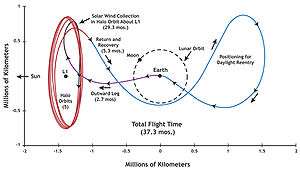Kathleen Howell
Kathleen Howell is an American scientist and aerospace engineer known for her contributions to dynamical systems theory applied to spacecraft trajectory design which led to the use of halo orbit in multiple NASA space missions. She is currently the Hsu Lo Distinguished Professor at Purdue University in the School of Aeronautics and Astronautics.[1]
Career
She obtained her Bachelor of Science degree in Aerospace Engineering at Iowa State University in 1973. Howell then received her MS and PhD degrees from Stanford University in 1977 and 1983, respectively. Her PhD advisor was John Breakwell and her PhD dissertation was entitled "Three-dimensional, periodic halo orbits in the restricted three-body problem". Howell started as an assistant professor at Purdue University School of Aeronautics and Astronautics in 1982 and is the School's first female tenured professor.

Howell's work[2] on computing the characteristics of the invariant manifolds associated with halo orbits was first applied for design of trajectory for Genesis mission and enabling low-energy sample return from Sun-Earth L1 point. The spacecraft trajectory for Genesis exploiting Howell's manifold method was computed by Howell and her student Brian Barden during a weekend in August 1996 after an urgent request from Jet Propulsion Lab scientist Martin Lo.[3]
Awards and honors
Howell is a 1984 winner of the 1984 Presidential Young Investigator Award, presented to her at the White House by Ronald Reagan, and the 2004 recipient of the Dirk Brouwer Award from the American Astronautical Society.[4]
In 2017 Kathleen Howell was elected to National Academy of Engineering with a citation "For contributions in dynamical systems theory and invariant manifolds culminating in optimal interplanetary trajectories and the Interplanetary Superhighway".[5]
Papers
References
- ↑ "Kathleen Howell". Purdue University. Retrieved 2009-04-15.
- ↑ Howell, K; Barden, B; Lo, M (1997). "Application of Dynamical Systems Theory to Trajectory Design for a Libration Point Mission". Journal of Astronautical Sciences. 45 (2): 161–178.
- ↑ Taubes, Gary (June 1, 1999). "Surfing the Solar System". Discover. Retrieved August 17, 2017.
- ↑ "Dirk Brouwer Award". American Astronautical Society. Retrieved 2009-04-15.
- ↑ "NAE Members Directory: Kathleen Connor Howell".
- ↑ Howell, K. C.: "Three-Dimensional, Periodic, 'Halo' Orbits", Celestial Mechanics, Volume 32, Number 53, 1984
External Links